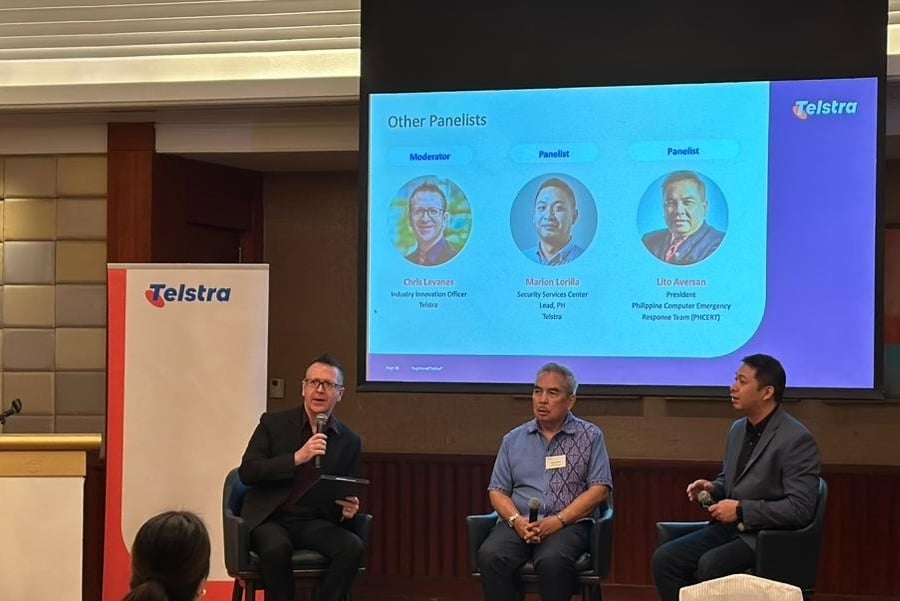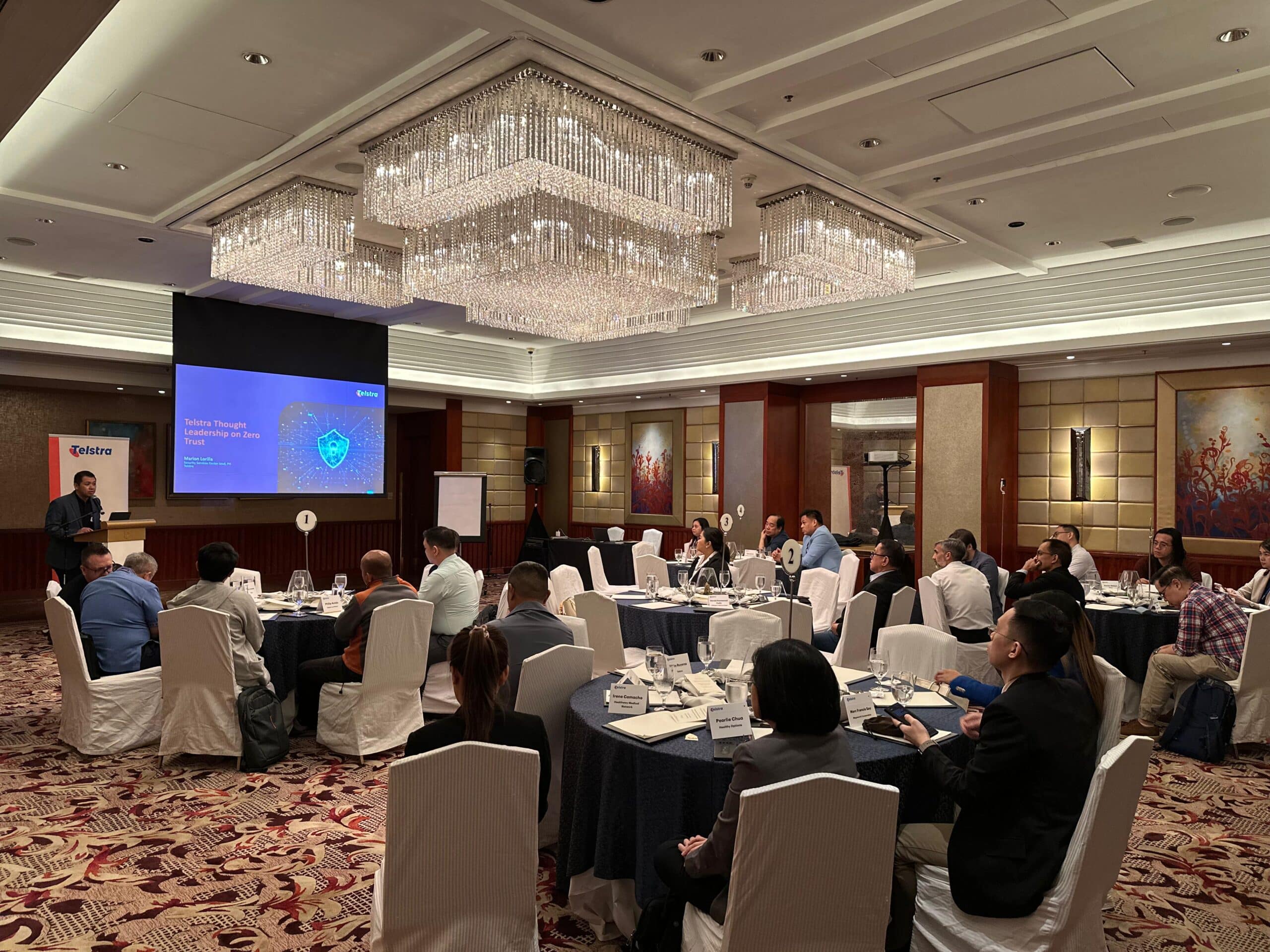Redefining Filipino cybersecurity practices within the AI era
The innovation-risk equation
In the 9th edition of Google’s annual e-Conomy SEA Report – released in November 2024 – the Philippines has emerged as the fastest-growing digital economy in Southeast Asia. The Department of Trade and Industry welcomed the findings, attributing success to various e-commerce initiatives.

(L-R) Chris Levanes from Telstra International, Lito Averia from PhCERT, and Marion Lorilla from Telstra International discussed the new cybersecurity threats and frontiers.
While ongoing investments in innovation are critical for virtually every business to be competitive both locally and globally, correspondingly, digitization broadens the cyber-attack surface for them and their customers.
As a nation, the Philippines is recognized to be responding in a forward-looking manner to the cyber threat landscape. For example, in the September 2024 United Nations/International Telecommunication Union Global Cybersecurity Index annual report, the Philippines jumped from Tier 3 to Tier 2, indicating progress in cybersecurity commitment and maturity.
Yet, the cyberthreat landscape is constantly evolving, and is now also being fueled by the malicious use of AI. Put simply, continued focus is needed to protect corporate assets.
At a recent executive luncheon by Telstra International, Filipino business and technology leaders gathered to discuss securing enterprises in the AI era.
The tectonic impact of AI upon cybersecurity

Business and technology leaders gathered to share cybersecurity practices in the AI era.
Renowned cybersecurity expert and President of the Philippine Computer Emergency Response Team (PhCERT) Lito Averia said attackers and defenders are both leveraging emerging technologies.
“AI is changing the threat landscape and security practices for businesses,” said Averia. “Attackers are recognizing the enormous potential of AI to create new types of malware and attacks.”
According to Chris Levanes – Industry Innovation Officer at Telstra International, recent research has shown that AI-generated attacks can be more effective. A 2024 independent social engineering threat study indicated that Large Langue Model (LLM)-generated phishing messages have more than four times the click-through rates (54%) than arbitrarily generated ones (12%).
Averia also added that security incidents and events management (SIEM) systems often generate millions of records for enterprises. “It is both crazy and frustrating for cybersecurity professionals to analyze the deluge of data and alerts manually, in which to attempt to create threat insights” he added.
Marion Lorilla – Telstra International’s Philippines Service Security Centre Lead – indicated that cybersecurity platforms are increasingly being embedded with AI to help with threat hunting & detection, as well as response & remediation.
The new security frontier
Mitigating threats solely at the perimeter are no longer adequate. The rise of decentralized applications and distributed workforces are requiring businesses worldwide to revise their security strategy, according to Levanes. This is particularly true in the Philippines, where more employees prefer either hybrid or remote working conditions to avoid travel costs or traffic congestion.
“This new working model affects how organizations secure their businesses,” said Levanes. “Businesses are moving away from the concept of securing network perimeters and devices to focus upon the vital practice of zero trust and identity centricity,” he said.
“Data and workers are constantly in motion; hence relying upon your perimeter as a security control point is no longer viable,” said Lorilla. He further highlighted “the importance of identity verification of users and devices attempting to access any organization’s resources, regardless of whether they are inside or outside the network perimeter. Moreover, establishing baselines of human-to-machine or machine-to-machine interactions can facilitate the determination of legitimate and potentially suspicious activities”.
Tackling talent shortage
One business leader at the event conveyed their perspective that despite emerging technologies, talent shortages remain a major frustration for organizations seeking to enhance cybersecurity.
Averia acknowledged that concern by signifying “PhCERT estimates that the Philippines requires about 180,000 cybersecurity workers across many different levels to address the nation-wide cyber-skills gap.” He also stated, “while academic institutions offer quality cybersecurity courses, unfortunately, many graduates are not industry-hardened upon entering the workforce. Additionally, certifications are costly for individuals and companies, causing a shortage of certified cybersecurity professionals.”
Levanes indicated that this is equally a worldwide challenge, as according to the World Economic Forum’s 2025 Global Cybersecurity Outlook report, only 14% of organizations are confident that they have the critical cyber people and skills they need today.
Lorilla advocated for businesses to supplement internal skills with capabilities from external vendors. As an illustrative example, he indicated that subscribing to Telstra International’s services is an effective way to achieve an optimal cyber posture. Via certified experts located in Australia, Manila and London, Telstra offers round-the-clock monitoring with the latest managed technical capabilities – for instance, extended detection and response, security service edge, identity and access, security operations as-a-service – as well as consulting and professional services by certified cyber specialists.
“The Philippines continues to successfully compete on an international scale. The industry’s focus on cybersecurity to protect assets and data is critical from both a national standpoint and business growth perspective,” Levanes concluded.
ADVT.
This article is brought to you by Telstra through Ignite Content Marketing Limited.